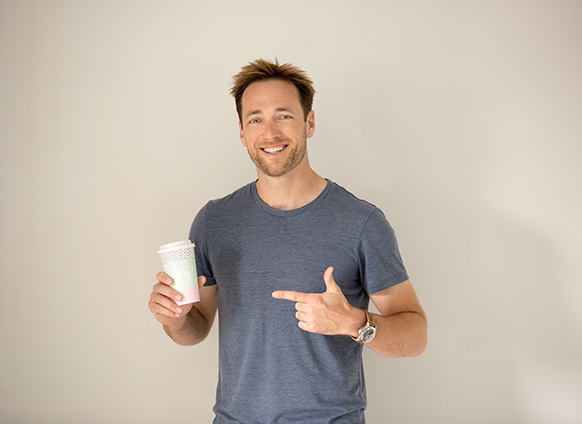PJ Brice is really excited about sippy cups. The 39-year-old British-born former semipro rugby player has the charm and zeal of a natural-born entrepreneur, but he is especially animated when he talks about lidded cups, bibs, lunch boxes and snack containers. Those children’s products are one of many collections that are on the drawing board for Cheeky, a fast-growing, mission-driven and design-forward disposable tableware company that Brice launched two years ago. The product line has, as he sees it, the potential to go the farthest in solving one of society’s most intractable ills, which is also the company’s cause: hunger.
Cheeky is one of the latest and most successful examples of social entrepreneurship or philanthropic capitalism. Giving back is embedded in the company’s DNA. For every packet of paper or plastic plates, bowls, napkins or cutlery purchased, 10 cents goes to Feeding America, the country’s largest hunger relief organization, which redistributes donated food from manufacturers, grocery stores, packers and growers to food banks across the country. Those 10 cents cover the cost of getting one meal to a person in need. Cheeky’s first products—blue-and-white chevron pattern and multicolor striped paper tableware—hit Target shelves in November 2014 in an exclusive distribution deal. Since then Cheeky has helped provide more than 6 million meals.

KYLE DEWITT
But Brice wants to do more. “Cheeky started out with a very simple concept: Sell some products and provide some meals to the hungry,” Brice says. “But in doing so, what are we achieving? In some ways we’re just perpetuating the issue. It’s like giving someone a fish versus giving them a fishing rod.”
Cheeky Kids might just be that fishing rod. Brice directs a visitor at Cheeky’s headquarters in El Segundo, California, to a vision board just outside of his office. It holds mock-ups of plates, napkins and bowls, all whimsically illustrated. “Through the development of a super-hip collection of products for children,” says Brice, pointing to the board with pride, “we can engage and educate an entire generation to play a role in ending hunger.” When the collection launches in early 2017, it will be supported by messages about hunger directed at both parents and kids at every point of interaction, from packaging to a website and a newsletter. “We don’t want to lecture people,” Brice says. “We want to engage them with soundbites that are meaningful and impactful. We want to create an empowered community.”
“Cheeky started out with a very simple concept: Sell some products and provide some meals to the hungry.”
There’s a lot more in Cheeky’s pipeline. In June three lines of dinnerware were introduced at Target, with a fourth design scheduled to debut in October. In five or so years, Brice sees disposables as only a small part of the business. Although he says the expansion plans are still confidential, he can’t help but give a hint of what’s in the works. “Think of housewares and food prep where fashion could play an integral role, such as placemats, tablecloths, silicone baking mats. We want the Cheeky line to be the experience you have when you shop in a beautiful European housewares store or Williams-Sonoma.”
However elevated Cheeky’s offerings may become, serving the cause remains front and center. “Brice is incredibly mission-driven and it’s something you hear in every conversation you have with him,” says Sebastian Dinges, Cheeky’s director of operations and one of the company’s nine full-time employees. And it’s not just talk. Once a month, Cheeky’s offices shut down so the staff can spend the day volunteering with a hunger organization. Recently they were at the Los Angeles Mission, prepping food and serving meals to the large homeless population of Skid Row. “I’ve lived in L.A. for 15 years, and I’ve never been to Skid Row,” Brice says. “I don’t know what words to use to describe the experience. It was appalling, ghastly, shocking.”
Related: 3 Steps to Build More Meaning Into Your Business
A Turning Point
Many entrepreneurs can point to an aha moment when the vision for their startup came into focus. Brice had two of them. The first was about five years ago when he and his wife, Kim, saw actor-musician Jeff Bridges in concert in Santa Barbara, California, where they live with their three young children. Bridges, who founded the nonprofit End Hunger Network, which mobilizes the entertainment industry to help end childhood hunger, shared some grim statistics from the stage: Nearly 50 million Americans, including almost 17 million children, are food-insecure.
Those figures stunned Brice, who’d first come to the U.S. from his small village in Somerset County, England, to work at a summer camp in the Adirondacks as a teenager. He returned to play rugby in Ohio after college and then again a few months later, at age 22, to join Allegro, a cosmetics and travel bags manufacturer. “Kim and I were blown away,” Brice says. “The figures [were] so outrageous, they were hard to believe. It just seemed fantastical that one in six or one in seven Americans is food-insecure and that’s happening in every single community in America.”
A couple of years later, in January 2014, after 15 years with the company, Brice left Allegro. He had helped build the company into a global brand and stayed to assume the role of president after it was acquired by Conair. He was ready for a new challenge. “I’d become aware of the role that for-profit businesses like TOMS Shoes and Warby Parker were playing in helping address major issues in our society,” he says. He’d been talking to friends Ido Leffler and Lance Kalish, the Australian founders of the natural beauty company Yes To, about launching a business together. Leffler and Kalish had started a nonprofit Yes To Seed Fund that provides grants for starting school gardens and teaching kids about nutrition.
They all agreed that hunger relief would be the cause of their socially good company. They even had a name in place: Cheeky—defined as “irreverent in an endearing manner.” As Leffler told Brice during one of their many late-night calls, “We’ve had this brand name bouncing around. We weren’t sure where we were going to use it, but it’s such a positive word we thought it would be great for something here in the States.”
All they needed was to find a vehicle to finance their cause, one that would not only be well intentioned, but also big enough to make a real difference.
Aha, Round Two
In the spring of 2014 that vehicle arrived with Brice’s second eye-opening moment. Kim had asked Brice to pick up some paper products for one of their frequent barbecues. He went to his local Target and was struck by how every section of the store was filled “with an abundance of innovation, style and designer collaborations”—except the paper-plate aisles. “There was a ton of footage devoted to paper products,” he says, “but all of it was boring and poorly designed. An alarm bell went off in my mind. Here was this big blank space ready to be filled.”
Related: 3 Steps to Execute a Successful Idea
The three Cheeky partners had strong relationships with Target, and after Brice’s momentous stroll down the paper-plate aisle, they began the conversation. The Target execs embraced the idea of disrupting disposable tableware, an area dominated by a few huge manufacturers, such as Georgia-Pacific, which owns Dixie. “Target is very keen to do everything they possibly can to differentiate themselves from their competition in the marketplace,” Brice says. “If they could have the exclusive rights to a fashion-forward, cool, millennial-oriented brand in what’s clearly a big and fast-growing category, they see it as a great game-changing differentiator. Their response was, ‘Let’s go for it!’ ”
Six months after initial conversations, the first Cheeky assortment was prominently displayed on Target aisle endcaps. “From day one, sales were fabulous,” says Brice, Cheeky’s CEO (Leffler and Kalish are board members). “But very quickly we learned that there were some redundancies in the line.” For example, there was a near-disastrous investment in bulk napkins. “At one point we had $2.5 million in napkin inventory that we didn’t know what to do with because it was a crappy item,” Brice says. “Thankfully, we worked out a plan with Target and our supplier to burn through it by selling it at a deep discount. But had we not had that support, it could have ended everything.”

KYLE DEWITT
That hiccup aside, Cheeky has been successful at making a throwaway item into a chic and Instagram-able one, so much so that 30 percent of the customers buying Cheeky are first-time paper-plate buyers. Aiding the newfound customers are collaborations with well-known designers, including Molly Hatch, a ceramicist and artist who creates housewares for Anthropologie. These collaborations, along with recruiting celebrity chef Mario Batali as a culinary ambassador, have boosted Cheeky’s presence.
For all of this success, and for all of his confidence and passion, Brice says there are still a lot of sleepless nights and stressful mornings. “Every day when I wake up and go through my inbox, there could be any number of things that could derail the business. We’re still a startup and while we’ve gotten some traction, we need to be incredibly resourceful and ready to take on anything that might come up.”
He stays focused on long-term goals. “If we work really, really hard and catch a few breaks, I can see us becoming, in five or 10 years, a nationally or internationally known brand that’s synonymous with playing a really cool role in ending hunger or going some way to improve the status quo. And that’s a lot of pressure because I’d hate to be the person who slips up and makes a wrong decision that takes us off track from realizing that amazing goal.”
Still, Brice wouldn’t have it any other way. One of his favorite sayings is “a life untested is a life unlived.” “You have to push yourself,” he says. “You have to put yourself out there. You’re going to get shot at from time to time when you’re on the front lines, but it’s much better to be in the trenches than watching from the sidelines.”
Related: When You Want to Chicken Out, Use These 6 Motivating Quotes to Push Forward
This article originally appeared in the July 2016 issue of SUCCESS magazine.




